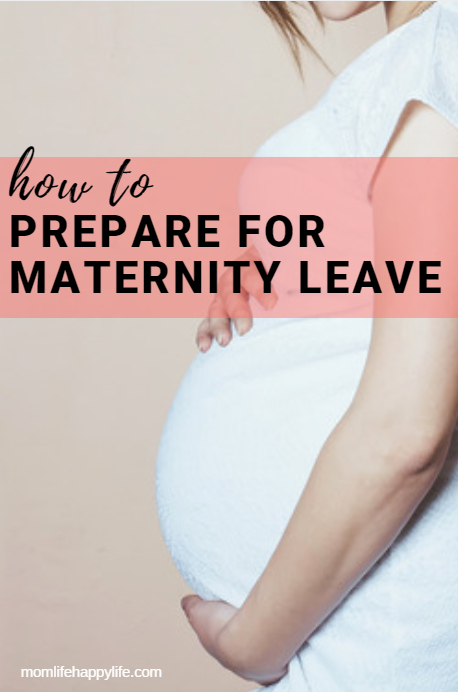8 Smart Ways To Prepare For Maternity Leave At Work
How To Prepare For Maternity Leave The Right Way
There are more than 31million working mothers in the United States alone. If you’ve found out you’re expecting a baby, congratulations, you might be joining that rank soon. If you’re a working mom to be, here’s how to successfully plan for maternity leave at work. There’s so much to do and prepare for! However, you can use these tips for a smooth transition and you’ll be leaving work behind for newborn cuddles.
You might absolutely love your job and you’re concerned about how this life changing news will affect your career. Or you’re working at a job you simply tolerate and want to decide what to do about your work status after the baby arrives. If either one of these are you, keep reading for the steps to help you with your transition.
Do Your Research
Before you announce the news to your boss, you’ll want to familiarize yourself with your company’s policy about maternity leave and benefits.
- Every company is not required to provide paid or non paid maternity leave. Check your employer’s leave policy and see if you are eligible for any leave.
- You may be eligible for time through the Family and Medical Leave Act (FMLA). Under these regulations, a mother can be allowed 12 weeks of non paid job protected leave for the birth of a child.
Questions to Ask Your Human Resources Rep About Maternity Leave
Don’t hesitate to go to your company’s human resources (HR) department if you have questions or need clarification about the information you find in the policy. Examples of questions to ask your human resources department about maternity leave include:
- Does the company offer paid maternity leave?
- Are short term disability benefits available for compensation during maternity leave?
- How do I apply for leave?
- Is my health insurance coverage still valid during maternity leave? How are these premiums covered?
- Will maternity leave affect my eligibility for raises and promotions?
- Can I take additional time for complications?

Develop a Maternity Leave Coverage Plan
Typically after you have completed your first trimester of pregnancy, you will probably tell your immediate manager. Telling your boss that you’re pregnant can make you nervous, but if you share the news and your intentions to develop a plan for coverage in your absence you’ll be well on your way to successfully prepare for maternity leave at work.
Here are few basic suggestions to help you ready your boss and coworkers for your leave.
- Document your day to day workflow or processes. Make note of any special projects you may be working on.
- Work directly, one on one with the person or people who will be doing your job duties for job training to ensure they have sufficient training on how to do your work.
- Set up your auto reply for your work email. If appropriate or applicable leave a point of contact or phone number that someone can contact in your absence.
Set Boundaries for Employer Contact
Decide if or when your employer can contact you about work related issues while you’re out on maternity leave. It can be tempting to pop in to answer a few questions or emails, but your focus should be on your baby during those early days. You can request that you be contacted during an emergency situation only. This is will keep you in the loop but will not distract from your precious time with your newborn.
How To Prepare Financially For Maternity Leave at Work
It’s no secret that baby expenses can add up. Those little humans can cost an awful lot, starting from the day they’re born with that crazy hospital bill. Here’s how to prepare your finances that will decrease your stress about money so you can focus on your baby.
The sooner you can start saving for your baby expenses, the better prepared you will be. Start by reviewing your budget, ideally you’ll want to be spending less than you make. By cutting costs, you can save money for your baby’s future as well as the unpaid time you might have for maternity leave. If your budge is already lean and you cant cut it anymore, consider saving “extra money” such as tax refunds or work bonuses.
Some first time moms assume that they will be able to work up until they deliver. It is important that you do not make this assumption, pregnancy complications cannot be predicted. Getting a head start on saving money can help you if this happens to you.
Planning to Return to Work
At some point before or even during your leave, you may question whether you want to return to work. Many first time moms don’t know how they will feel about the responsibility of caring for a newborn. Once they’ve had some time caring for a new baby, they may decide they want to be a stay at home mom. You truly wont know how you feel until the time comes.
If you do decide that you will not be returning to work, let your employer know of your plans. Not returning after your leave can affect your paid benefits and you’ll need to know if reimbursement is required.
Explore Childcare Options After Maternity Leave is Up
If you are returning to work after having a baby, one of the most important steps when planning for maternity at work is what you’ll do for childcare. If it seems too early to think about this sort of thing, consider that by preparing for the care of your child now, you won’t be scrambling later.
Another advantage to exploring childcare arrangements earlier during pregnancy? Some daycare facilities have waiting lists just to get in! Researching what childcare options are available while you’re pregnant will give you the opportunity to explore what childcare arrangement will work best for your family. 
Get It In Writing
You’ve worked so hard to prepare for maternity leave at work and you have a solid but flexible plan for what will happen in your absence. It’s a really good idea to have a written copy of your plan for yourself, as well as your boss and colleagues. The people who are covering for you will know exactly what to do and your boss will thank you!
If you are able to do even some or all of these things in anticipation for your leave from work, then you will be prepared the best you can be for the unexpected!
Don’t forget to thank your boss and coworkers as you will appreciate their help during your time off. Finally, take some time to relax knowing your work plans are done and you can enjoy your maternity leave!
Have you started planning for your maternity leave? How do you plan to make the change from work to home go smoothly?
 I’m Lachelle, a millennial mama, beauty lover and iced coffee enthusiast. I blog over at The Glam Mommy where I talk about all things mom life, beauty and style. I’m here to help you find your glow so that you look good and feel great while navigating motherhood.
I’m Lachelle, a millennial mama, beauty lover and iced coffee enthusiast. I blog over at The Glam Mommy where I talk about all things mom life, beauty and style. I’m here to help you find your glow so that you look good and feel great while navigating motherhood.





The United States presents itself as being the forerunner of civilization, land of the free, were its people are afforded opportunities others could only dream of. At the very core of a civilized society is the family. Why is it that mothers in the United States are treated as a burden on the economy and are being deprived of their rights as a mother to care and nurture their babies in their first year of life? The U.S. is only one of three countries in the civilized world that deny their women the appropriate provision of paid maternity leave. Women between the ages of 16-25 who do not receive adequate time off after giving birth, have a higher susceptibility of experiencing depressive disorders later in life, than for those who do receive time off. It has also been shown that mothers who are granted paid maternity leave, have an increased loyalty to their pre-birth employers. There are significant benefits for the health and wellbeing of the newborn, such as improved bonding and better emotional development, when the mother is able to continue care, rather than returning to work too soon. If the U.S. were to enact paid maternity leave at the federal level, they would be joining many other countries that invest in their families and in turn their future.